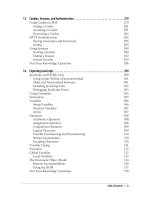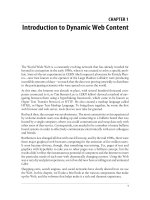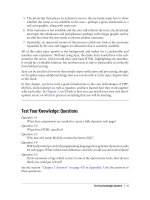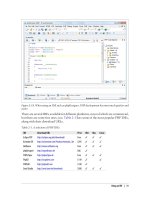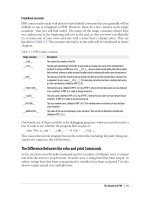Học php, mysql và javascript - p 34 ppt
Bạn đang xem bản rút gọn của tài liệu. Xem và tải ngay bản đầy đủ của tài liệu tại đây (1.59 MB, 10 trang )
Character Meaning
\\ Backslash
\XXX An octal number between 000 and 377 that represents the Latin-1 character equivalent (such as \251 for the ©
symbol)
\xXX A hexadecimal number between 00 and FF that represents the Latin-1 character equivalent (such as \xA9 for
the © symbol)
\uXXXX A hexadecimal number between 0000 and FFFF that represents the Unicode character equivalent (such as
\u00A9 for the © symbol)
Variable Typing
Like PHP, JavaScript is a very loosely typed language; the type of a variable is determined
only when a value is assigned and can change as the variable appears in different con-
texts. Usually, you don’t have to worry about the type; JavaScript figures out what you
want and just does it.
Take a look at Example 14-8, in which:
1. The variable n is assigned the string value “838102050”, the next line prints out its
value, and the typeof operator is used to look up the type.
2. n is given the value returned when the numbers 12345 and 67890 are multiplied
together. This value is also 838102050, but it is a number, not a string. The type
of variable is then looked up and displayed.
3. Some text is appended to the number n and the result is displayed.
Example 14-8. Setting a variable’s type by assignment
<script>
n = '838102050' // Set 'n' to a string
document.write('n = ' + n + ', and is a ' + typeof n + '<br />')
n = 12345 * 67890; // Set 'n' to a number
document.write('n = ' + n + ', and is a ' + typeof n + '<br />')
n += ' plus some text' // Change 'n' from a number to a string
document.write('n = ' + n + ', and is a ' + typeof n + '<br />')
</script>
The output from this script looks like:
n = 838102050, and is a string
n = 838102050, and is a number
n = 838102050 plus some text, and is a string
If there is ever any doubt about the type of a variable, or you need to ensure a variable
has a particular type, you can force it to that type using statements such as the following
(which respectively turn a string into a number and a number into a string):
Variable Typing | 311
n = "123"
n *= 1 // Convert 'n' into a number
n = 123
n += "" // Convert 'n' into a string
Or, of course, you can always look up a variable’s type using the typeof operator.
Functions
As
with PHP,
JavaScript functions are used to separate out sections of code that perform
a particular task. To create a function, declare it in the manner shown in Example 14-9.
Example 14-9. A simple function declaration
<script>
function product(a, b)
{
return a*b
}
</script>
This function takes the two parameters passed, multiplies them together, and returns
the product.
Global Variables
Global variables are ones defined outside of any functions (or within functions, but
defined without the var keyword). They can be defined in the following ways:
a = 123 // Global scope
var b = 456 // Global scope
if (a == 123) var c = 789 // Global scope
Regardless of whether you are using the var keyword, as long as a variable is defined
outside of a function, it is global in scope. This means that every part of a script can
have access to it.
Local Variables
Parameters passed to a function automatically have local scope. That is, they can be
referenced only from within that function. However, there is one exception. Arrays are
passed to a function by reference, so if you modify any elements in an array parameter,
the elements of the original array will be modified.
To define a local variable that has scope only within the current function, and has not
been passed as a parameter, use the var keyword. Example 14-10 shows a function that
creates one variable with global scope and two with local scope.
312 | Chapter 14: Exploring JavaScript
Example 14-10. A function creating variables with global and local scope
<script>
function test()
{
a = 123 // Global scope
var b = 456 // Local scope
if (a == 123) var c = 789 // Local scope
}
</script>
To
test whether scope setting has worked in PHP, we can use the isset function. But
in JavaScript there isn’t one, so let’s make our own—it’s sure to come in handy in the
future—with Example 14-11.
Example 14-11. A version of the isset function for JavaScript
<script>
function isset(varname)
{
return typeof varname != 'undefined'
}
</script>
This function makes use of the typeof operator, which returns the string “undefined”
when a variable is not defined. So let’s use it to test our isset function in Example 14-12.
Example 14-12. Checking the scope of the variables defined in function test
<script>
test()
if (isset(a)) document.write('a = "' + a + '"<br />')
if (isset(b)) document.write('b = "' + b + '"<br />')
if (isset(c)) document.write('c = "' + c + '"<br />')
function test()
{
a = 123
var b = 456
if (a == 123) var c = 789
}
function isset(varname)
{
return typeof varname != 'undefined'
}
</script>
The output from this script is the following single line:
a = "123"
Global Variables | 313
This shows that only the variable a was given global scope, which is exactly what we
would expect, given that the variables b and c were given local scope by prefacing them
with the var keyword.
If your browser issues a warning about b being undefined, the warning is correct but
can be ignored.
The Document Object Model
The designers of JavaScript were very smart. Rather than just creating yet another
scripting language (which would have still been a pretty good improvement at the time),
they had the vision to build it around the Document Object Model or DOM. This
breaks down the parts of an HTML document into discrete objects, each with its own
properties and methods, and each subject to JavaScript’s control.
JavaScript separates objects, properties, and methods using a period (one good reason
why + is the string concatenation operator in JavaScript, rather than the period). For
example, let’s consider a business card as an object we’ll call card. This object contains
properties such as a name, address, phone number, and so on. In the syntax of Java-
Script, these properties would look like this:
card.name
card.phone
card.address
Its methods are functions that retrieve, change, and otherwise act on the properties.
For instance, to invoke a method that displays the properties of object card, you might
use syntax such as:
card.display()
Have a look at some of the earlier examples in this chapter and look at where the
statement document.write is used. Now that you understand how JavaScript is based
around objects, you will see that write is actually a method of the document object.
Within JavaScript, there is a hierarchy of parent and child objects. This is what is known
as the Document Object Model (see Figure 14-3).
The figure uses HTML tags that you are already familiar with to illustrate the parent/
child relationship between the various objects in a document. For example, a URL
within a link is part of the body of an HTML document. In JavaScript, it is referenced
like this:
url = document.links.linkname.href
Notice how this follows the central column down. The first part, document, refers to the
<html> and <body> tags, links.linkname to the <a > tag and href to the href=
element.
314 | Chapter 14: Exploring JavaScript
Let’s turn this into some HTML and a script to read a link’s properties. Type in Ex-
ample 14-13 and save it as linktest.html, then call it up in your browser.
If you are using Microsoft Internet Explorer as your main development
browser, please just
read through this section, then read the section
titled “Browser Incompatibilities” on page 316 and then come back and
try the example with the getElementById modification discussed there.
Without it, this example will not work for you.
Example 14-13. Reading a link URL with JavaScript
<html>
<head>
<title>Link Test</title>
</head>
<body>
<a id="mylink" href="">Click me</a><br />
<script>
url = document.links.mylink.href
document.write('The URL is ' + url)
</script>
</body>
</html>
Note the short form of the script tags where I have omitted the parameter
type="text/JavaScript" to save you some typing. If you wish, just for the purposes of
testing this (and other examples), you could also omit everything outside of the
<script> and </script> tags. The output from this example is:
Click me
The URL is
Figure 14-3. Example of DOM object hierarchy
The Document Object Model | 315
The second line of output comes from the document.write method. Notice how the
code follows the document tree down from document to links to mylink (the id given
to the link) to href (the URL destination value).
There is also a short form that works equally well, which starts with the value in the
id attribute: mylink.href. So you can replace this:
url = document.links.mylink.href
with the following:
url = mylink.href
Browser Incompatibilities
If you tried Example 14-13 in Safari, Firefox, Opera, or Chrome, it will have worked
just great. But in Internet Explorer (even version 8) it will fail, because Microsoft’s
implementation of JavaScript, called JScript, has many subtle differences from the rec-
ognized standards. Welcome to the world of advanced web development!
So what can we do about this? Well, in this case, instead of using the links child object
of the parent document object, which Internet Explorer balks at when used this way,
you have to replace it with a method to fetch the element by its id. Therefore, the
following line:
url = document.links.mylink.href
can be replaced with this one:
url = document.getElementById('mylink').href
And now the script will work in all major browsers. Incidentally, when you don’t have
to look the element up by id, the short form that follows will still work in Internet
Explorer, as well as the other browsers:
url = mylink.href
Another use for the $ sign
As mentioned earlier, the $ symbol is allowed in JavaScript variable and function names.
Because of this, you may sometimes encounter some strange-looking code, like this:
url = $('mylink').href
Some enterprising programmers have decided that the getElementById function is so
prevalent in JavaScript that they have written a function to replace it called $, shown
in Example 14-14.
Example 14-14. A replacement function for the getElementById method
<script>
function $(id)
{
return document.getElementById(id)
316 | Chapter 14: Exploring JavaScript
}
</script>
Therefore, as long as you have included the $ function in your code, syntax such as:
$('mylink').href
can replace code such as:
document.getElementById('mylink').href
Using the DOM
The links
object is
actually an array of URLs, so the mylink URL in Example 14-13 can
also be safely referred to on all browsers in the following way (because it’s the first, and
only, link):
url = document.links[0].href
If you want to know how many links there are in an entire document, you can query
the length property of the links object like this:
numlinks = document.links.length
You can therefore extract and display all links in a document like this:
for (j=0 ; j < document.links.length ; ++j)
document.write(document.links[j].href + '<br />')
The length of something is a property of every array, and many objects as well. For
example, the number of items in your browser’s web history can be queried like this:
document.write(history.length)
However, to stop websites from snooping on your browsing history, the history object
stores only the number of sites in the array: you cannot read from or write to these
values. But you can replace the current page with one from the history, if you know
what position it has within the history. This can be very useful in cases in which you
know that certain pages in the history came from your site, or you simply wish to send
the browser back one or more pages, which is done with the go method of the
history object. For example, to send the browser back three pages, issue the following
command:
history.go(-3)
You can also use the following methods to move back or forward a page at a time:
history.back()
history.forward()
In a similar manner, you can replace the currently loaded URL with one of your choos-
ing, like this:
document.location.href = ''
The Document Object Model | 317
Of course, there’s a whole lot more to the DOM than reading and modifying links. As
you progress through the following chapters on JavaScript, you’ll become quite familiar
with the DOM and how to access it.
Test Your Knowledge: Questions
Question 14-1
Which tags do you use to enclose JavaScript code?
Question 14-2
By default, to which part of a document will JavaScript code output?
Question 14-3
How can you include JavaScript code from another source in your documents?
Question 14-4
Which JavaScript function is the equivalent of echo or print in PHP?
Question 14-5
How can you create a comment in JavaScript?
Question 14-6
What is the JavaScript string concatenation operator?
Question 14-7
Which keyword can you use within a JavaScript function to define a variable that
has local scope?
Question 14-8
Give two cross-browser methods to display the URL assigned to the link with an
id of thislink.
Question 14-9
Which two JavaScript commands will make the browser load the previous page in
its history array?
Question 14-10
What JavaScript command would you use to replace the current document with
the main page at the oreilly.com website?
See the section “Chapter 14 Answers” on page 446 in Appendix A for the answers to
these questions.
318 | Chapter 14: Exploring JavaScript
CHAPTER 15
Expressions and Control Flow in
JavaScript
In the last chapter I introduced the basics of JavaScript and DOM. Now it’s time to
look at how
to construct complex expressions in JavaScript and how to control the
program flow of your scripts using conditional statements.
Expressions
JavaScript expressions are very similar to those in PHP. As you learned in Chapter 4,
an expression is a combination of values, variables, operators, and functions that results
in a value; the result can be a number, a string, or a Boolean value (which evaluates to
either true or false).
Example 15-1 shows some simple expressions. For each line, it prints out a letter be-
tween a and d, followed by a colon and the result of the expressions (the <br /> tag is
there to create a line break and separate the output into four lines).
Example 15-1. Four simple Boolean expressions
<script>
document.write("a: " + (42 > 3) + "<br />")
document.write("b: " + (91 < 4) + "<br />")
document.write("c: " + (8 == 2) + "<br />")
document.write("d: " + (4 < 17) + "<br />")
</script>
The output from this code is as follows:
a: true
b: false
c: false
d: true
Notice that both expressions a: and d: evaluate to true. But b: and c: evaluate to
false. Unlike PHP (which would print the number 1 and nothing, respectively), actual
strings of “true” and “false” are displayed.
319
In JavaScript, when checking whether a value is true or false, all values evaluate to
true with the exception of the following, which evaluate to false: the string false itself,
0, −0, the empty string, null, undefined, and NaN (Not a Number, a computer engi-
neering concept for an illegal floating-point operation such as division by zero).
Note how I am referring to true and false in lowercase. This is because, unlike in PHP,
these values must be in lowercase in JavaScript. Therefore only the first of the two
following statements will display, printing the lowercase word “true,” because the sec-
ond will cause a “‘TRUE’ is not defined” error:
if (1 == true) document.write('true') // True
if (1 == TRUE) document.write('TRUE') // Will cause an error
Remember that any code snippets you wish to type in and try for yourself
in an HTML
file need to be enclosed within <script> and </script> tags.
Literals and Variables
The simplest form of an expression is a literal, which means something that evaluates
to itself, such as the number 22 or the string “Press Enter”. An expression could also
be a variable, which evaluates to the value that has been assigned to it. They are both
types of expressions, because they return a value.
Example 15-2 shows five different literals, all of which return values, albeit of different
types.
Example 15-2. Five types of literals
<script>
myname = "Peter"
myage = 24
document.write("a: " + 42 + "<br />") // Numeric literal
document.write("b: " + "Hi" + "<br />") // String literal
document.write("c: " + true + "<br />") // Constant literal
document.write("d: " + myname + "<br />") // Variable string literal
document.write("e: " + myage + "<br />") // Variable numeric literal
</script>
And, as you’d expect, you see a return value from all of these in the following output:
a: 42
b: Hi
c: true
d: Peter
e: 24
Operators let you create more complex expressions that evaluate to useful results.
When you combine assignment or control-flow construct with expressions, the result
is a statement.
320 | Chapter 15: Expressions and Control Flow in JavaScript

